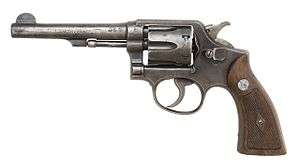Smith & Wesson Model 586
| Smith & Wesson Model 586 | |
|---|---|
 586-7 Revolver with 7-round capacity and factory wood grips | |
| Type | Revolver |
| Place of origin | United States |
| Production history | |
| Manufacturer | Smith & Wesson |
| Variants |
|
| Specifications | |
| Barrel length |
|
|
| |
| Cartridge | |
| Action | Double action |
| Feed system | 6 round cylinder |
| Sights | Adjustable rear open sights |
The Smith & Wesson Model 586, is a six- or seven-shot double-action revolver chambered for the .357 Magnum cartridge.
It is essentially the same weapon as the S&W Model 686, but the 586 has a blued steel construction, while the 686 has a stainless steel construction. Also, since the 586 was directed more to law enforcement, most have shorter barrels than the 686.
Description
It will chamber and fire .38 Special cartridges, as the .357 Magnum was developed from the .38 Special. The magnum case is slightly longer (0.1 in) to prevent magnum rounds from being chambered and fired in handguns chambered for the .38 Special. The 586 has been available with 2½ in, 3 in, 4 in, 6 in, and 8⅜" in (64, 76, 102, 153, and 214 mm) barrel lengths as standard models and other barrel lengths either by special order from S & W's Performance Center custom shop, or acquired from or built by after-market gunsmiths.[1]
The Model 586 uses S & W's L (medium) revolver frame, with a K-Frame sized grip mated to a larger diameter cylinder. During the 1980s, Smith & Wesson developed its L-Frame line of .357 Magnums: the Model 581, Model 586, Model 681 and Model 686. The Model 581 had a fixed notch type rear sight, whereas the 586 used a target style adjustable rear sight. These handguns had a major effect on both law enforcement and sporting markets. The 586 was introduced in 1980 and the 581 was discontinued in 1988.[1]
According to Jim Supica and Richard Nahas in their book Standard Catalog of Smith & Wesson; 3rd Edition (Gun Digest Books, Lola WI. 2006)
The K-frame .357 magnum revolvers became immensely popular as police revolvers. However some felt that extensive firing of full power .357 ammunition in the relatively light framed guns was wearing on both gun and shooter. There appeared to be a demand for a .357 that handled like a K frame but offered the heft and durability of an N frame. The L frame was introduced as this compromise size, with design input from Roy Jinks (official S&W company historian), and quickly established itself in the law enforcement and hunting markets. L frames also generally feature a full-length under-barrel lug, which adds recoil-absorbing weight to the gun.[1]
It was manufactured in either blue or nickel-plated versions. A stainless steel version exists as the Model 686. Other variations, such as the Model 686+, chambered for 7 rounds, are available. In the late 1990s, Smith & Wesson discontinued production of all but a few blued revolvers, thus the Model 686 and its variants are the only models currently produced. In 2012, Smith & Wesson brought back the 586 in its 4-in. and 6-in. barrel lengths as part of its Classic line of revolvers. The 586-8 features a redesigned and improved yoke.[1]
Model 586 Variants
- 586, 1981 Intro
- 586-1, 1986 Radius stud package, floating hand.
- 586-2, 1987 Change hammer nose and associated parts.
- 586-M, 1987 Product warning by S&W, M overstamp to indicate factory mod (for 586 and 586-1)
- 586-3, 1988 New yoke retention system. 1992 Delete 8 3/8" barrel and four-position front site. 1992 Delete nickel finish
- 586-4 1994 Drill and tap, synthetic grips, change rear sight and extractor. 1995 Delete square butt. 1997 Delete 8 3/8" barrel, change to MIM thumb piece.
- 586-5, 1998 Change design to eliminate cylider stop stud. Change to MIM hammer with floating firing pin, change to MIM trigger, change internal lockworks.
- 586-7, 2006 Limited Edition. 7-shot variant only.
- 586-8, 2012 Reintroduced under Smith & Wesson's Classic lineup. 6-shot only.
Model 686 Variants
The Smith & Wesson Model 686 is a stainless-steel version of the post-1980 L-frame revolver.
- 686 no dash, introduced model
- 686-1, 1986, radius stud package, floating hand
- 686-2, 1987, changed hammer nose, bushing and associated parts
- 686-3, 1988, new yoke retention system
- 686-4, 1993, change rear sight leaf, drill and tap frame, change extractor, hogue grips
- 686-5, 1997, change frame design to eliminate cylinder stop stud, eliminate serrated tangs, change to MIM hammer with floating firing pin, change to MIM trigger, change internal lockwork
- 686-6, 2001, internal lock
Recall
In 1987, seven years after the release of the Model 586, there were reports of cylinder binding with some types of standard .357 Magnum ammunition for L-frame revolvers manufactured before August of 1987. S&W put out a product warning and authorized a no-charge upgrade to make modifications to all 586, 586-1, 686, 686-1, and 686CS-1 revolvers.[2]
References
- 1 2 3 4 Standard Catalog of Smith & Wesson; 3rd Edition, Jim Supica and Richard Nahas, Gun Digest Books, Iola WI. 2006
- ↑ Product Warning, Popular Mechanics, January 1988, p. 11.
| |||||||||||||||||||||||||||||||||||||||||||||||||||||||||||||||||||
